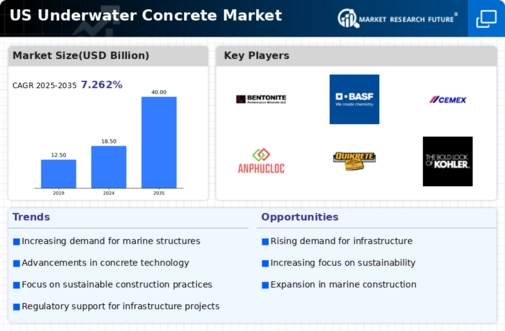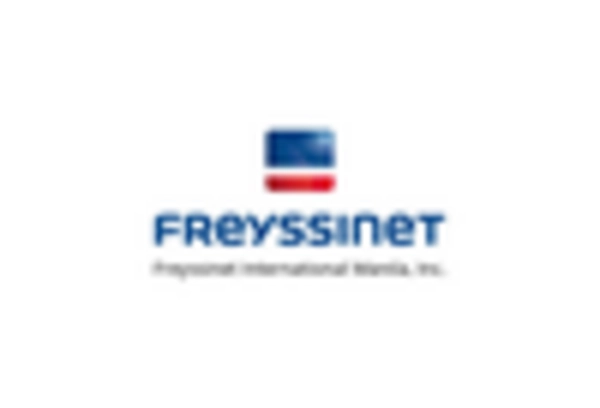Infrastructure Development Initiatives
The ongoing infrastructure development initiatives in the US are likely to bolster the underwater concrete market. With the government investing heavily in upgrading and maintaining bridges, tunnels, and marine structures, the demand for specialized construction materials, including underwater concrete, is expected to rise. According to recent estimates, the US infrastructure spending is projected to reach approximately $1 trillion by 2027, which could significantly impact the underwater concrete market. This surge in investment is anticipated to create opportunities for contractors and suppliers, as they seek durable and efficient materials to meet the rigorous demands of underwater construction projects. As a result, the underwater concrete market may experience substantial growth driven by these infrastructure initiatives.
Increased Marine Construction Activities
The rise in marine construction activities in the US is a pivotal driver for the underwater concrete market. As coastal cities expand and the need for ports, harbors, and offshore structures increases, the demand for underwater concrete is likely to grow. The US Army Corps of Engineers has reported a steady increase in marine construction projects, with expenditures reaching around $5 billion annually. This trend suggests that the underwater concrete market will benefit from the heightened activity in marine environments, necessitating innovative concrete solutions that can withstand harsh underwater conditions. Consequently, the market may see a surge in demand for specialized underwater concrete formulations designed for durability and performance.
Regulatory Support for Sustainable Practices
Regulatory support for sustainable practices is emerging as a key driver for the underwater concrete market. The US government is increasingly implementing regulations that promote environmentally friendly construction methods, which include the use of sustainable materials in underwater applications. This regulatory landscape encourages the adoption of eco-friendly concrete solutions, such as those incorporating recycled materials or low-carbon alternatives. The underwater concrete market stands to gain from these regulations, as they align with the growing emphasis on sustainability in construction. As a result, companies that prioritize sustainable practices may find themselves at a competitive advantage, potentially leading to increased market share and profitability in the underwater concrete sector.
Technological Innovations in Concrete Formulations
Technological innovations in concrete formulations are transforming the underwater concrete market. Advances in material science have led to the development of high-performance underwater concrete that exhibits superior strength and durability. Innovations such as self-compacting concrete and fiber-reinforced concrete are gaining traction, providing enhanced performance in underwater applications. The underwater concrete market is expected to benefit from these advancements, as they allow for faster construction times and reduced labor costs. Furthermore, the integration of smart technologies in concrete, such as sensors for monitoring structural integrity, is likely to attract investment and interest from various stakeholders. This trend indicates a promising future for the underwater concrete market as it adapts to the evolving needs of the construction sector.
Growing Demand for Resilient Construction Materials
The growing demand for resilient construction materials is influencing the underwater concrete market. As climate change impacts become more pronounced, there is an increasing emphasis on building structures that can withstand extreme weather events and rising sea levels. The underwater concrete market is positioned to meet this demand, as underwater concrete offers enhanced durability and resistance to environmental factors. Recent studies indicate that resilient construction materials can reduce long-term maintenance costs by up to 30%, making them an attractive option for developers and contractors. This shift towards resilience in construction is likely to drive the underwater concrete market, as stakeholders seek materials that ensure longevity and sustainability in their projects.

















Leave a Comment